
How do sewers work in the City of Kingston?
Since sewers are underground, the way they work is likely a mystery for most homeowners. If you want to know some basics about how both sanitary sewage and storm runoff are dealt with in the City of Kingston, read on.
Sewer types
There are three types of sewers in the City of Kingston:
- The sanitary sewer collection system: This system is an underground network of pipes responsible for collection of sanitary sewage and drains mostly by gravity, but requires pumping here and there, and ultimately flows to one of two wastewater treatment plants. West Kingston is one service area and drains to the Cataraqui Bay Wastewater Treatment Plant. Sewage from Central Kingston is pumped under the Great Cataraqui River where is joins with sewage from East Kingston and drains to the Ravensview Wastewater Treatment Plant. Figure 1 illustrates the flow direction of sanitary sewage in the City of Kingston.
- The storm sewer system: This system is responsible for collection of storm runoff throughout the City and drains entirely by gravity to the nearest water body, whether a watercourse or the lake. The storm drainage system is comprised of two parts; i) the minor system, which is an underground network of pipes, and; ii) the major system, which is the above-ground gravity flow paths. Note that in order to get into the pipes, storm runoff usually needs to flow on the surface to collection points, called “catch basins”, which are often located along the side of the road. Note that in some areas, the minor system is comprised of road-side ditches, rather than pipes. Storm sewers are not located everywhere.
- Combined sewers: In essence, combined sewers are part of the sanitary sewer collection system, because the go to a wastewater treatment plant. However, the difference is that it collects both sanitary sewage and storm runoff in a single pipe. Overflow points were purposely constructed in combined sewers to prevent basement flooding because of the variability of flows associated with wet-weather and snowmelt.
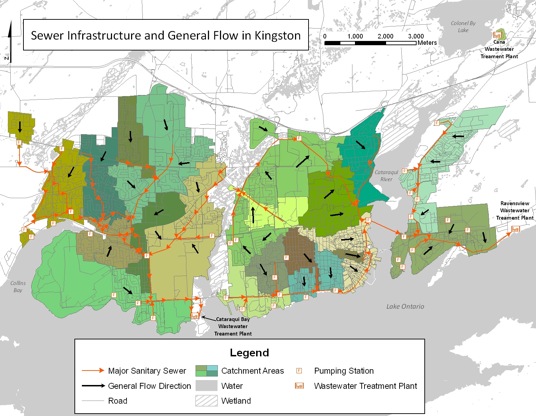
Figure 1
Sewer Infrastructure in the City of Kingston
Servicing
In very general terms, overall drainage servicing will use one of two servicing forms:
- Separated sewer servicing: This means that sanitary sewage is collected by a sanitary sewer, and storm runoff is collected by a storm sewer. This also means that you have a sanitary sewer in front of your house. It also means that there are either ditches or storm pipes that service your street, or at minimum, a pre-planned overland flow path to catch-basins that service your street.
- Combined sewer servicing: This means that both sanitary sewage and storm runoff are collected in one pipe – the combined sewer. This means that you will have a combined sewer in front of your house, which collects all the sanitary sewage from you and your neighbours, but also collects runoff that enters the catch basins.
The following figure shows where combined sewer servicing still exists in the City of Kingston. The remainder of the City of Kingston is serviced by separated sewers.
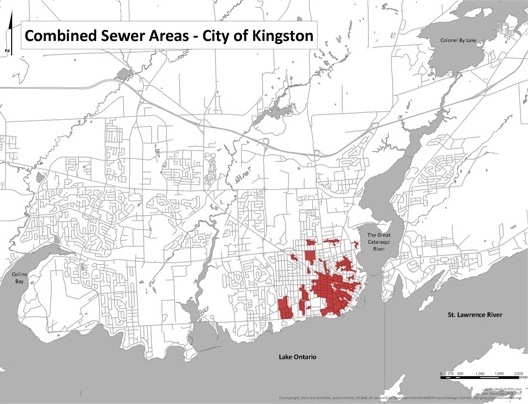
Figure 2
Areas of Kingston still using combined sanitary and storm sewers
Storm sewers are not always required to exist on every street block in order for an area to be considered “separated”. As mentioned above, the above-ground flow path of storm water runoff forms part of the storm sewer system. So, water may need to flow off your property, onto the road, and down the road to a catch basin before it enters the storm sewer. This is part of traditional storm sewer design.
Some points about each type of servicing are noteworthy, and the table below is intended to help with this understanding.
| Type of Sewer | Diagram | Details |
|---|---|---|
| Combined | 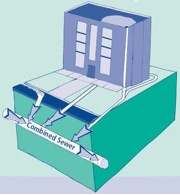 |
|
| Partially separated |
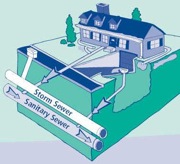 |
|
| Fully separated |
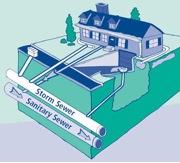 |
|
Combined sewers are not built anymore because they contribute to overflows to the environment and add to the potential for sewage backups.
Separated sewers are a bit more complicated. Why? As you see in the table above, it really depends on where the storm water and groundwater from private properties are going. If the downspouts and foundation drainage from homes go into the sanitary sewer, it is not truly and fully “separated” and a considerable amount of otherwise clean water can get into the sanitary sewer. This type of servicing is more accurately called Partially-Separated Sewer Servicing. Distinct storm and sanitary sewers are present, but not all the storm water is getting to the storm sewer where it should be – some is going into the sanitary sewer. The amount of storm and ground water coming from private-properties, as well as from leaks and cross-connections on the sanitary sewer mains puts homes at risk of sewage backups.
When all storm and groundwater from private-side sources are directed to either the lawn for infiltration, or to the storm sewer, this is referred to as Fully-Separated Sewer Servicing. This is what the City of Kingston strives for.